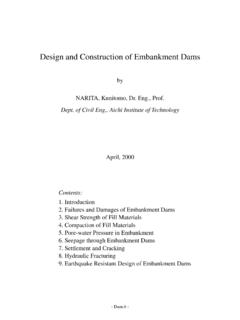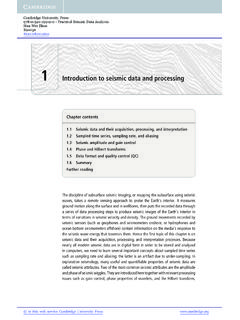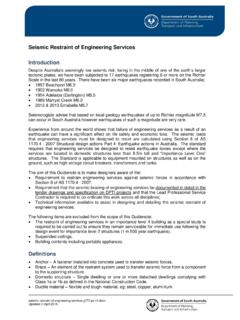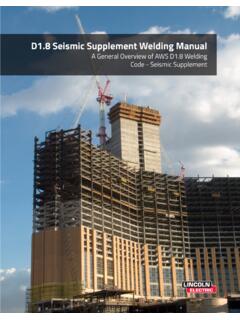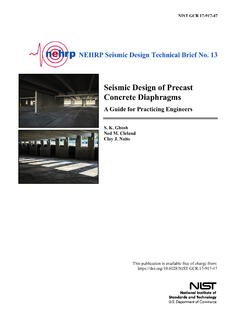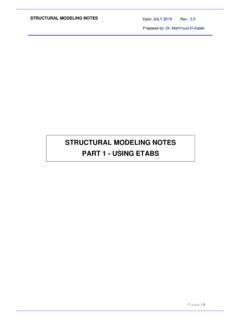Transcription of Design and Construction of Embankment Dams
1 Design and Construction of Embankment Dams by NARITA, Kunitomo, Dr. Eng., Prof. Dept. of Civil Eng., Aichi Institute of Technology April, 2000. Contents: 1. introduction 2. Failures and Damages of Embankment Dams 3. Shear Strength of Fill Materials 4. Compaction of Fill Materials 5. Pore-water Pressure in Embankment 6. Seepage through Embankment Dams 7. Settlement and Cracking 8. Hydraulic Fracturing 9. Earthquake Resistant Design of Embankment Dams . 1. introduction . Preface Dams, which are constructed of earth and rock materials, are generally referred to as Embankment dams or fill-type dams. The history of Construction of Embankment dams is much older than that of concrete dams. It is evident that some earth dams were constructed about 3,000. years ago in the cradles of ancient cultures such as east countries. According to the standard manual provided by the International Commission on Large Dams (ICOLD), in which about 63 member countries are now associated, dams with the height of more than 15m are referred to as "high dams".
2 About 14,000 high dams have been registered up to the present, and more than 70 percent of them are Embankment dams. A recent report on the Construction of high dams has also noted that among about 1,000 of high dams constructed in recent two years, just about 20 percent are concrete dams and remaining 80 percent are Embankment dams. It is thus readily recognized that Construction of Embankment dams is a recent world-wide trend in place of concrete dams. Two major distinct features and advantages are noticed for the Construction of Embankment dams. 1. Rigorous conditions are not required for the dam foundation, while hard and sound rock foundation is necessary for concrete dams. Embankment dams can be constructed even on the alluvial deposit and pervious foundations. 2. Construction of Embankment dams has an economical advantage; , the dam project can be planned in the outskirts of city area because of the merit mentioned above, and Construction materials are principally to be supplied near the dam site.
3 In this brief note, several important issues associated with the Design and Construction of Embankment dams, which engineers often encounter in the dam project, are summarized, and some discussions are given on them by introducing recent development of Design procedures and Construction technology. Types of Embankment Dams Embankment dams are classified into two main categories by types of soil mainly used as Construction materials, such as earthfill dams and rockfill dams. The latter ones further can be classified into a few groups by configurations of dam sections, as one with a centrally located core, one with an inclined core and one with a facing, as shown in The main body of rockfill dams, which should have a structural resistance against failure, consists of rockfill shell and transition zones, and core and facing zones have a role to minimize leakage through Embankment . Filter zone should be provided in any type of rockfill dams to prevent loss of soil particles by erosion due to seepage flow through Embankment .
4 In earthfill dams, on the other hand, the dam body is the only one which should have both structural and seepage resistance against failure with a provided drainage facilities. The dam type in a project is determined by considering various factors associated with topography and geology of the dam site, and quality and quantity of Construction materials available. The inclined core is adopted instead of the center core, for instance, in cases where the dam foundation has a steep inclination along the river, where a blanket zone is provided in the pervious foundation to be connected with the impervious core zone, and where different Construction processes are available for the placement of core and rockfill materials.. Key Words: rockfill, transition .. pervious zone, to have structural strength core, facing .. impervious zone, to keep water tight filter .. to prevent loss of soil particles drain .. to pass water from upstream to downstream (to dissipate pore water pressure).
5 Core trench, grouting .. to keep water tight in the foundation (a) Homogeneous Earth Dam Phreatic surface Drain (b) Rockfill Dam with a Centrally Located Core Filter Outer Shell Inner Shell (Transition) Core Core Trench Curtain Grouting (c) Rockfill Dam with an Inclined Core Filter Random Drain Shell Core Curtain Grouting (d) Rockfill Dam with a Facing Facing Shell Earth and Rockfill Dams . Investigation, Design and Construction There are three main steps of working in a dam project: , investigation, Design and Construction . Individual works in these three steps are summarized as listed in with key words associated with them. Key Words Associated with Investigation, Design and Construction #Site Investigation: Check of dam planning for appropriate purposes /Meteorological and hydrological surveys /Topographical and geological investigations (landform, terrace, geological time, outcrop, lithofacies, folding, fault, discontinuity, erosion, weathering, sedimentation, stratum).
6 #Foundation Survey: Check of required conditions for a base foundation /Geophysical exploration (seismic prospecting, electrical prospecting, ..). /Boring exploration (core drilling, sampling, sounding), /Test pitting /In-situ testing (permeability, grouting, bearing capacity, compressibility). /Rock classification #Fill Materials: Check of required quality and quantity of materials /Geological survey (stratum, volume). /Laboratory testing (shear strength, compressibility, compaction, permeability,..). /In-situ testing (roller compaction, density log, field permeability, sampling). #Stability of Dam Body /Stability against sliding failure of Embankment (evaluation of pore-water pressure during and after Construction , shear strength and deformation characteristics of fill materials). /Seismic stability (seismic coefficient method, liquefaction, dynamic deformation characteristics, dynamic response analysis, earthquake resistant Design ).
7 /Stability at the contact face of dam body and base foundation (contact clay, compaction, relative displacement, arching, cracking). #Seepage Through Embankment and Foundation /Seepage analysis (discharge, pore-water pressure, leakage through foundation, critical velocity, piping, critical hydraulic gradient, hydraulic fracture). #Foundation Treatment /Stability (counterweight fill, relief well, inspection gallery). /Seepage (drainage facilities, grouting, blanket). #Planning for Construction / Construction equipment (roller, carrier, bulldozer, ..). /Foundation treatment (grouting, drainage). /Placement (execution management, field and laboratory testing). /Observation (pore-water pressure, settlement, earth pressure, deformation). #Maintenance and Repair . 2. FAILURES AND DAMAGES OF Embankment DAMS. Preface Most of catastrophic failures of Embankment dams causes by overtopping of the reservoir water due to flooding or loss of free board.
8 Despite Embankment dams should not be designed to withstand erosive action of water flow over the crest, case histories reveal that inadequate capacity of spillway, that is, insufficient estimation of the amount of flooding has often led to the failure of the Embankment due to overtopping. Failures of this type, however, can not be a decisive defect of Embankment dams, because the accumulation of available accurate data of hydrology and the improvement of Design method can readily settle the problem. This issue is therefore out of scope in this paper. Other main factors to cause Embankment failures are hydraulic erosion, high pore-water pressure, earthquake forces and so forth. More than 50 percent of Embankment failures are above all due to hydraulic erosion, and remaining each several percent is caused by other respective factors. Several typical patterns of failures and damages of Embankment dams and their foundations are illustrated in and Failure Causes of Embankment Dams a) Pore water pressure built-up during Construction During Construction b) Reduction of shear strength due to thixotropical property a) Hydraulic fracturing / Internal erosion / Piping b) Excess hydrostatic pressure due to rapid draw down After Construction c) Reduction in shear strength / Weathering, swelling of compacted soil d) Settlement and cracking e) Earthquake forces Over-topping (flood control).
9 Sliding Quick sand Boiling Leakage Embankment Piping Foundation Seepage force Earthquake Damage of Embankment Damage of foundation Sliding (by pore-water pressure, earthquake) Bearing capacity Deformation (settlement and lateral deflextion) Settlement Leakage Leakage Hydraulic fracture (quick sand and piping) Hydraulic fracture Liquefaction Damages in Embankment and Foundation . Sliding due to Pore-Water Pressure An excessive and abrupt increase of pore-water pressure, such as the one built-up during Construction and the residual one due to rapid drawdown of the reservoir, may cause sliding failures in Embankment . In , relatively high pore-water pressure was built-up in an earth dam, which led to a sliding failure during Construction . In , distribution of pore-water pressure at a usual stationary flow has changed during rapid drawdown, which caused a high excess pore-water pressure in the upstream part of the Embankment .
10 Built-up pore-water pressure Circular sliding P16. P11 P10 tips 250. Pore-water pressure (kPa). 200 u/ h . Triaxial Tests 150 (mean value). failed 100. P10. 50. P16. P11. 0. 0 50 100 150 200 250. Overburden pressure h (kPa). Sliding Failure During Construction Phreatic surface in Embankment almost remains unchanged when Initial water level upstream water level goes down Rapid rapidly because of low permeability drawdown Sliding of fill material Drain Hydro-static for Excess due to drawdown water level rapid drawdown Excee Pore-Water Pressure due to Rapid Drawdown . Seepage Failure (Hydraulic Fracture). When water flows passing through soil in an Embankment and foundation, seepage forces act on soil particles due to its viscosity. If seepage forces acting in the soil are large enough as compared to the resisting forces based on the effective earth pressure, erosion by quick sand takes place by washing soil particles away from the surface, and piping successively develops as erosion gradually progresses.
